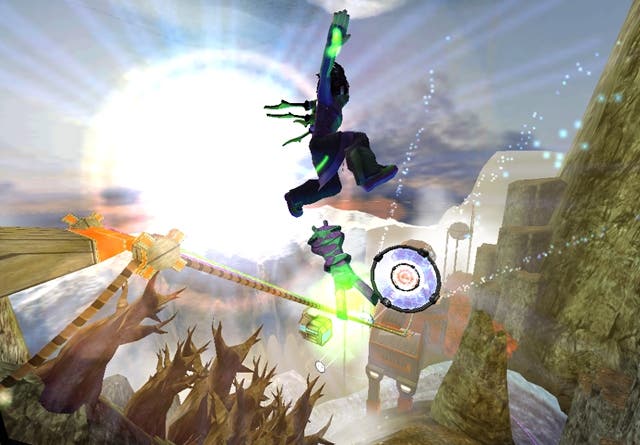EyeToy: AntiGrav
Put your hands in the air like you just want to turn left on your hoverboard.
Order yours now from Simply Games.
As a general rule, EyeToy games are only entertaining if you're very young, responsible for the very young, or drunk. Or all of the above, but that's a dangerous game.
That's not to say we weren't impressed when the first EyeToy title, Play, appeared back in the summer of 2003. After all, it was a great concept, it was like nothing we'd seen before, and it let you blap ninjas with your fists, inadvertently clocking nearby relatives curious to know what the hell you were up to.
Follow-up EyeToy: Groove was a little less exciting - featuring too much flappy dancing and not enough novelty value (effectively taking one element of Play and expanding it to a full game), or ninjas, and while other titles like Play 2 were enjoyable, they also suffered from the 'fun, but not for very long' factor.
Now Harmonix has attempted to do something a bit different with everyone's favourite camera peripheral. As you may recall, they're the folks behind music-based titles FreQuency and Amplitude, both of which were innovative, addictive and highly playable, and sold about four copies [most of which ended up in this house - Ed].
For its first EyeToy effort, it is boldly going where no developer has gone before. Trick is, AntiGrav is the first EyeToy title that doesn't display your image on screen - instead you see what looks like a typical third-person gamescreen with a character to control that bears no resemblance to you.

Unless, that is, you're some kind of hilarious cyberpunk [er, check - Ed] with a penchant for spiky hairstyles [check], racing goggles [*cough*] and clothes that look like they were made in space [guilty]. And - here's where the AntiGrav bit comes in - own a hoverboard [now, you see, that's where I fall down].
Ah, hoverboards. Ever since Back to the Future II, the world has longed for scientists to make them a reality, but have they bothered? No. Too busy working out how big space is, inventing yellow vacuum cleaners and finding a cure for cancer, no doubt, when they should be concentrating on what's really important.
This isn't the first time games developers have tried to keep us occupied with virtual hoverboards in the meantime - in November 2001, Sony published Criterion's under-rated Trickstyle pseudo-sequel Airblade. Imagine Tony Hawk with less gravity, basically. And more hoverboards.
Though innovative, addictive and highly playable, the game also sold about four copies (not that Criterion minded too much, we suspect, since another of its titles was launched just a week later and ended up doing somewhat better. Its name was Burnout).
Like Airblade, ET: Antigrav sees you zooming round on a hoverboard, knocking out tricks, collecting pick-ups and trying to beat the clock. The difference is you control your character with your body instead of a Dual Shock.

It works like this: tilt your head left and right to steer, spread your arms out to brake, wave them around to perform tricks, bend your knees to duck down and go faster, and jump to jump.
There's an in-game tutorial to get you used to all this, and to introduce basic concepts such as grinding on rails and reaching out to hit targets. But despite the clear instructions, one thing quickly becomes very clear - controlling your character with precision and timing for any kind of prolonged period is not an easy task.
This is because, sadly, the EyeToy camera is just not a sophisticated enough piece of equipment for the task at hand. It's supposed to track the movement of your head but all too often it's too slow to keep up and will sometimes lose it completely, mistakenly following a shoulder or arm as the central point instead.
As you might expect this can make steering impossible, let alone performing stunts, and the result is stilted, frustrating gameplay.
Which is a real shame as there's potential here for an EyeToy title with long-term value. It looks great - the characters are detailed and move well, when the camera's behaving, and the tracks are well-designed futuristic WipEout-style affairs complete with neon lighting, industrial backdrops and a funky Apollo 440 soundtrack.

There are two options for the solo player. Style mode lets you run wild through a series of arenas, hitting targets, flying through rings and collecting tokens as you go.
You also score points for doing tricks, many of which are pretty simple to perform: raise one arm to do a caveman roll, for example, or two for a backflip. But it's fun to experiment and find out what else can be achieved by thrashing around in different directions.
In Speed mode it's all about linear tracks and making it over the finish line first, but there's still plenty of scope for picking up goodies and pulling off stunts. Both modes are also available in multiplayer for up to four players, taking turns in front of the telly to compete against each others' ghosts.
When it works, it's great. There is a genuine feeling of immersion when you duck down or tilt to one side and see your character do the same, and a lot of satisfaction to be had from performing a well-timed jump or executing a flashy trick. It's just a shame that the good times never seem to last for very long before the EyeToy loses its focus and sends you spinning out of control.
Interestingly, when AntiGrav was first announced in May last year, it's unique-selling point was the use of something called 'colour-recognition technology'. "Unique armbands enable players to activate the colour tracking capabilities of the EyeToy USB camera," said Sony.

We can't help wondering if it was a mistake to lose those armbands along the way - they must have had some part to play if they were part of the original design, and perhaps they could have improved things. They couldn't have made them any worse, unfortunately.
It's a pity we can't give AntiGrav a higher score - we like the innovation, we like the presentation, and we like games with hoverboards in. In fact, it's easy to wonder how good this game would be with a conventional controller.
But the fact is it's played with an EyeToy camera, a piece of technology which isn't sophisticated enough to keep up with what the game is trying to do, no matter how well-thought out or executed.
Which makes for inconsistent, wearisome gameplay, and means we can't really recommend a purchase. If you're a diehard EyeToy obsessive who's prepared to spend hours restarting levels and recalibrating the camera, then maybe. If not, forget it. Even if you're young or drunk.
Order yours now from Simply Games.








